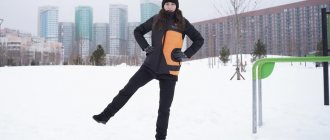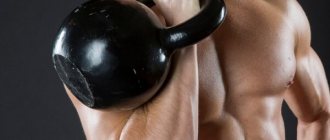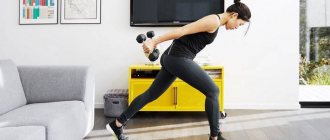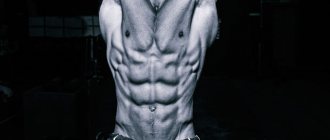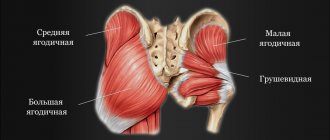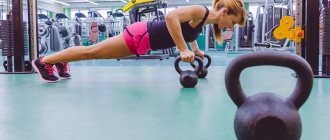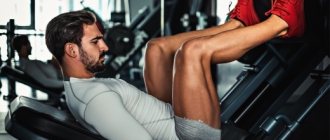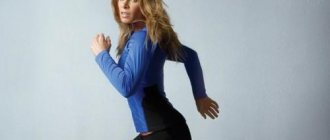The physique is determined by the sizes, shapes, proportions and features of the location of different parts of the body relative to each other.
Depending on this, you can easily make your figure more beautiful: remove the “excess” somewhere, and add muscle shape somewhere.
We bring to your attention specially selected programs for each body type.
Surely you have already heard about the pear-apple, hourglass body types... However, when it comes to correcting your physical shape with the help of a physical activity program, the three body types described are not enough, since there are several mixed body types, where the characteristics of some body types overlap with others.
So, we can distinguish 6 types, conventionally named by the letters of the Latin alphabet: T, A, O, H, I and X. Let's look at each type with examples of training.
T-type or inverted triangle
Women with a T body type need to focus on the lower body. Intensely train your buttocks so that they become more convex - this volume will help remove the impression of “flat” shapes and give the body an attractive roundness
Body Features:
- “boyish” appearance;
- tendency towards thinness;
- broad shoulders;
- small breasts;
- tendency to gain weight in the upper body;
- slim waist;
- narrow hips;
- thin legs, small calves.
Exercises for T-type (for outer thighs)
Perform forward lunges (for the inner thighs) with dumbbells.
Perform three sets of 15–20 repetitions on one leg, then on the other leg.
Lying leg curl
Lie down on a leg curl machine bench. Bend your legs with maximum amplitude until your thighs touch the machine’s roller. During leg extension, do not relax the muscles. Perform three sets of 12–15 repetitions.
Standing calf raise (for inner calves)
Stand on a stand 15–20 cm high, turn your socks at an angle of 45 degrees outward. Rise as high as you can to stand on your toes, then slowly lower yourself, bringing your heels closer to the floor.
Perform three sets of 15–20 repetitions.
Additional exercises:
These upper body exercises will help you gain the volume that this body type usually lacks.
Bent-over dumbbell row
Perform three sets of 12–15 repetitions.
Lifting dumbbells in front of you (for the front parts, deltoids)
Stand with your feet apart, lift the dumbbell with both hands up to head level, and slowly lower it to the starting position.
Perform three sets of 10–15 repetitions.
(for chest muscles)
Lie on a bench with an incline of 30 degrees (dumbbells to your shoulders). Straighten your arms, “squeezing” the weight, then slowly lower the dumbbells down.
Perform three sets of 10 repetitions.
Aerobic exercise
After an athletic workout, do aerobics for 20–30 minutes on any of the machines: rowing machine, stair machine, ski machine, stationary bike, or just walking with weights.
The best complexes for women
For girls who have not been actively involved before, a type of cyclic (circular) training is suitable. In this complex, several exercises are repeated several times - 5 exercises of 4 circles. When choosing, you should focus on the capabilities of your body, but it is recommended to increase the load with each new day - the number of repetitions and time to complete.
Example:
- classic squats – 60 sec;
- push-ups on knees – 60 sec;
- leg lunges - 45 sec;
- elbow bar – 30.
For more experienced ones, exercises using weights are suitable - these can be dumbbells or, if they are not available, bottles with sand or water will do.
Example:
- squats with dumbbells – 30 times;
- oblique twists – 20 times;
- push-ups on toes – 10 times;
- “bicycle” - 60 seconds;
- lunges with dumbbells – 20 times.
For those who can consider themselves to be in the category of “advanced” athletes, the following exercises are suitable:
- slow squats - with knees bent, hold for 20 seconds. – 30 times;
- pull-down to the belt - taking a weight in your hands, tilt your back to the floor, while inhaling, pull your arms towards you - 20 repetitions;
- twisting – lying down, pump the press 25 times.
A-type or triangle
This body type is the most common. The most difficult areas are in the pelvis and hips, where excess fat is most often deposited.
Body Features:
- “pear-shaped” body shape;
- “non-athletic” muscles;
- narrow chest, narrow back;
- protruding belly;
- tendency to accumulate fat in the pelvic area;
- wide pelvis, large buttocks.
Another disadvantage is the low tone of the muscles of the shoulder girdle. To compensate for the “unathleticism” of the upper body, it is necessary to focus on exercises for the shoulder girdle, pectoral muscles and triceps.
Exercises for type A
Swing your leg to the side
Three approaches 20-30 times on each leg, you can use weights.
Inclined leg press (to remove the “breeches” - loose parts of the thighs).
Place your feet on the top of the platform (legs apart) at a distance of 20 centimeters parallel to each other. Squat down slowly; when going up, do not stop, lift your pelvis off the machine (you can also lift your heels off the platform).
Perform three sets of 15–20 repetitions.
Dumbbell bench press (for the sides of the chest)
Raise the dumbbells forward, lower them down to your shoulders (until the muscles are tense), hold your hands in this position for one count, then slowly raise them forward.
Perform three sets of 10 repetitions.
Lateral dumbbell raises (for shoulder girdle muscles)
Raise the dumbbells to the sides, round your elbows, and turn your palms down. Slowly lower the dumbbells to the starting position.
Perform three sets of 12–14 repetitions.
(for abdominal muscles – lower bundles)
Hanging on the bar, bend your legs as much as possible (knees to chest)
Perform three sets of 15 repetitions.
Aerobic exercise
After strength exercises, move on to aerobic exercises: dance aerobics, step, ski or stair training, stationary bicycle or gliding machine.
Home workout program for beginners
Beginners should not be given a heavy load right away. Exercises without weights or with accessories such as expanders, fitness bands and elastic bands will be ideal here.
Home workout for beginners for girls without equipment:
- Raises the knees to the chest – 2x8 times.
- Plie squats – 2x8 times.
- “Bicycle” – 30-60 seconds.
- Side lunge – 2x8 times on each side.
- Lateral leg raise on all fours – 2x8 times on each side.
- Touching the ankles (lying on the floor with bent legs) – 2x20 times.
With fitness bands:
- Bent leg abduction to the side – 2x10 times for each leg.
- “Bicycle” – 2x12 times.
- Diagonal lunges – 2x12 times each.
- Leg lifts – 2x15 times each.
- Taking the legs back – 2x12 each.
O-type or "Apple"
Women of this type usually do not exercise at all and do not monitor their diet, which leads to disastrous results. But no matter how hopeless your figure may seem to you, you cannot despair. Hard and regular training will definitely bring success.
Body Features:
- pronounced fullness;
- cellulite;
- large breasts;
- rounded back (due to excess weight);
- full hands;
- protruding belly;
- rounded hip lines;
- the hamstrings and buttocks are not separated;
- massive calves.
Exercises for O-type
(for hamstrings)
Bend your legs with maximum amplitude, perform leg extensions with resistance at a slow pace.
When repeating the exercise for the second time, bend your legs only to half the amplitude, and perform leg extension with resistance at a slow pace.
Alternate full and incomplete repetitions, but count only complete ones.
Perform three sets of 15–20 repetitions.
Leg press (for buttocks)
Stand in the center of the platform of the vertical press machine (the distance between the feet is 30 cm, toes outward), transfer the weight to the heels.
Perform the bench press for three sets of 12–15 reps.
Russian twists (for the waist)
Perform torso turns to the right, then to the left, in a sitting position, sitting on the floor with your legs bent (keep your knees together).
Perform three sets of 50–75 repetitions (a repetition is considered to be turning the body to the right and left).
Abdominal retraction (for the waist)
Standing or kneeling, take a deep breath, pull in your stomach as much as possible, hold this position for 15-120 seconds, then relax your abdominal muscles and restore your breathing. Rest for a minute and repeat the exercise two more times.
Aerobic exercise
Be sure to include aerobic training (running, swimming, exercise bike) in your program - at least 3 times a week.
For beginners: start with 12 minutes and increase the duration of exercise by 2 minutes each week until you reach a half-hour workout without rest at your optimal heart rate.
How to create a training plan and scheme, depending on your goals
Home independent training is good because you can do it at your own pace and taking into account individual characteristics and preferences. There are a huge variety of options and everyone will select the necessary complex, but it is worth, first of all, to determine the purpose of the classes.
| Target | Principles for creating a training plan | Suitable exercises |
| Lose weight | Cardio training is required with high intensity and the use of all muscle groups | Raising the knees to hip level in place |
| Build muscles | Strength training with an emphasis on the desired zone | Raising the body, twisting; Squats, jump squats |
| Improve stamina | The program should include cardio classes. Load increase | Push-ups, plank |
| Prevention | Do exercises that you like without trying to increase your performance | Stretching |
I-type or rectangle
An I-shaped figure is characterized by thin bones and weak muscles. Representatives of this type have almost no fat deposits and have a high metabolic rate.
This figure needs to be added to its roundness, for this you need to combine a well-thought-out training program with a specially selected diet that will help you increase weight without “gaining fat.” You could have inherited such thinness or due to intense exercise, lack of appetite, or various diseases.
A calorie deficit combined with high-intensity training depletes the body. Excessive thinness is associated with too high a metabolic rate; gastrointestinal diseases, when nutrients are not fully absorbed; diabetes, which sometimes leads to weight loss.
It is recommended to adhere to the following rules during training:
- Lift heavy weights for relatively low reps. Sports science has clearly established that for anabolism (muscle tissue growth) it is necessary to perform 6-10 repetitions per set with heavy weights.
- The length of rest between sets depends on your goals. If you need to “burn” fat, rest should be short. The more often you train your muscles, the faster they will acquire the necessary roundness, but do not allow daily training - you only need to do bodybuilding no more than three times a week.
- To begin with, train once a day for at least two months, then try switching to a twice-daily training system. After three weeks of this schedule, return to one-time training. You also need aerobics to strengthen your cardiovascular system. Brisk walking for 20–30 minutes or swimming (three times a week) is recommended.
We recommend that you read the article How to gain weight quickly for a thin girl.
How much time do you need to study per day, week?
Doing sports training every day is the wrong approach; the body needs time to recuperate.
For beginner athletes, it is enough to train a couple of times every 7 days, evenly distributing the load. Over time, when the body gets used to it, you can increase the number of sessions up to 4-5 times. But these recommendations relate specifically to training – strength or cardio. It is useful to do ordinary exercises after waking up every day.
There is no ideal time of day to play sports; everyone chooses based on their preferences and biorhythms.
Don’t miss the most popular article in the section: Glutamic acid - what it is, why and how it is used in sports and bodybuilding.
H-shaped body type or “Brick”
An H-shaped figure is characterized by wide or medium bones, small breasts, and full legs. The visual impression is that the width of the shoulders, waist and pelvis is approximately the same.
In women of this type, there is a tendency to form fat deposits in the thighs and abdomen, and the metabolic rate is moderate. A big plus is always slender legs. Your muscles, which are naturally strong, respond very quickly to formative exercises with weights.
The main problem is the “sides”. The first task is to get rid of fat deposits. Belly fat is naturally given to you, so it is not so easy to remove it, since the fat cells on the waist are the largest and most fat-hungry.
You shouldn’t pump up your abs in hopes of “building a waist.” Stop: you don’t have it and never will. Physical exercise and nutrition cannot change the skeleton, but even deformity can be completely spoiled. Exercise alone will not help here - you also need to adhere to a low-calorie diet, aerobics and a training program aimed at the abdominal muscles.
Certain types of aerobics (45 minutes several times a week) specifically make the waist area “lose weight”!
The training program is built on the principle of separate training: on Wednesday and Saturday - exercises for the abs, and on Monday and Friday - for other parts of the body. As usual, aerobic training is included in the program to burn fat.
Exercises for H-type
Cardio
Your ideal cardio is where your midsection engages. The incline treadmill and stepper are your everything.
Strength training
Avoid exercises that place a lot of stress on your lower back. No heavy deadlifts, weighted crunches, or especially dumbbell side bends.
Allocate two workouts a week on legs and build them as follows: at the beginning of the workout - heavy complex exercises (all kinds of squats, bench presses), after - “grinding” with lunges, extensions, abductions.
In combination with confident, muscular legs, the torso will not look so massive. Heavy training will help you add muscle, but there is a nuance here: feel where the load is going and be able to remove it from those parts of the body where it is not needed.
Warm-up
Training at home begins with warming up the muscles. A good warm-up of your joints before exercise will protect your body from straining, and the pain the next day will not be as severe.
Technique:
- You need to start from the cervical region . Standing up straight, turn your head 2-3 times clockwise and counterclockwise. Next, tilt the head forward and backward, and to the sides.
- Hands . Simultaneously perform circular movements with both hands. Next, the same movement in the elbow joint. And finally, in the shoulder. You can do these exercises by counting up to four in one and the other direction.
- Legs. Similar to the above movements, alternately warm up the legs - feet, in the knee joints, then in the hip region. Can be supplemented with pelvic rotations - hands on the waist, legs together - smooth circular movements to count.
- Back. Having spread your legs as far as the stretch allows, make “springy” bends towards the left leg, in the middle, towards the right leg, return to the starting position - straighten the body. With your hands clasped behind your back, stretch forward, then move your hands in front of you and stretch them forward, and your back back.
Jogging in place is a good cardio activity that is suitable for warming up before a busy workout.
X-type or hourglass
An X-shaped figure is characterized by medium bones, a narrow waist, a full chest, the width of the shoulders is approximately equal to the width of the hips, fat deposits are formed on the buttocks and thighs, and an average metabolic rate.
The classic female physique is the hourglass. The main task is to maintain your physique, protect it from excess fat deposits, and not lose the elasticity of your body, and for this you need to do physical exercise and eat wisely, combining bodybuilding with aerobic training.
Full body workouts and interval cardio workouts are great options. See an example of a full body workout below:
Remember, the results of training cannot be lightning fast - you need to be patient, and your body will thank you.
The main thing is to have patience!
Advice from experts on organizing physical activity
Each trainer has his own approach to organizing workloads, but there are general principles based on which you can count on positive results when training at home.
Recommendations:
- Before classes, warm-up is required.
- The load should not be to the point of exhaustion.
- You should start with exercises for speed, agility and accuracy of movements.
- Only then on strength and endurance.
- Increase the load gradually.
- After finishing your workout, do exercises to calm your heart rate.
You need to track your workouts; it’s very easy to do at home. You can have a regular notepad or application, the main thing is to record the exercises planned and done.
Article design: Svetlana Ovsyanikova
